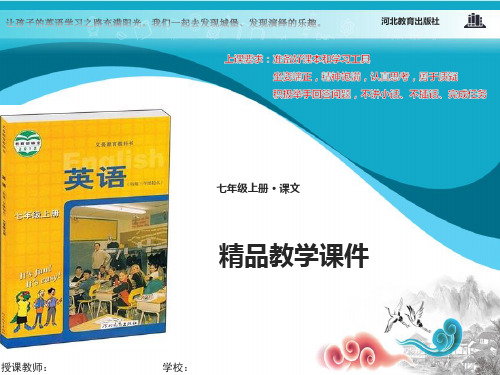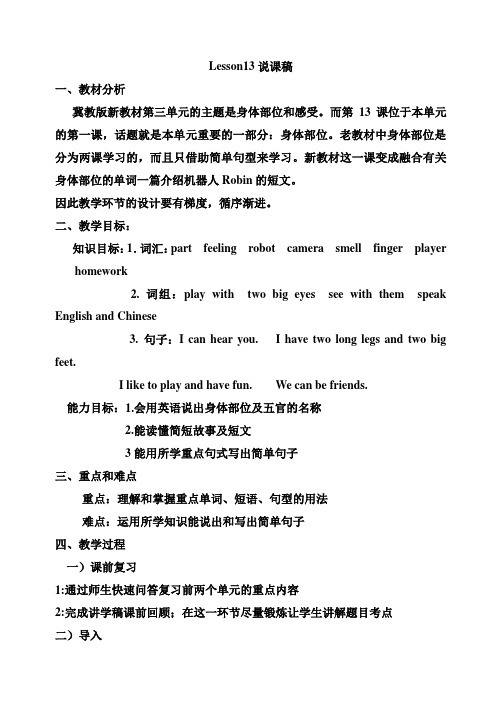冀教版-英语-七上-第13课Body Parts说课稿
冀教版-英语-七上-教案3单元 第13课 Body Parts

冀教版七上英语参考教案Unit 3 lesson 13 Body Parts 课时目标重点单词 part n . 部分 feeling n . 感觉;情感robot n .机器人camera n .照相机smell v . 嗅;闻起来finger n . 手指player n . 运动员;比赛者;选手homework n . 家庭作业重点短语 see with 用……看 smell with 用……闻talk with 用……说play with 和……一起玩turn around 转圈重点句子 1.I can smell with my nose. 我可以用我的鼻子闻。
2.And I can talk with my mouth.并且我可以用我的嘴讲话。
3.I don’t have ears but I can hear you.虽然我没有耳朵,但是我可以听见你说话。
4.I can make noodles with my long arms and small hands. 我可以用我长长的手臂和小巧的双手做面条。
5.I can write with them. 我可以用他们来写字。
6.I like to play and have fun! 我喜欢玩耍。
7.Do you want to play with me?你想和我一起玩吗?教学目标1.让学生了解如何介绍身体部位。
2.让学生了解如何介绍身体部位的功能。
4.让学生理解介词with 的基本用法。
教学难点 1.掌握一些与介绍身体部位有关的词汇2.激发学生兴趣,让学生运用所学知识介绍身体各部位能做的动作。
教学过程环节1 新课导入:教师在PPT 上展示几组照片,然后提出下列问题,同学们讨论并口头作答:(1)What are these ?(2)We can see with .(3)we can hear with .设计意图:通过图片展示更加直观地呈现本课时的主题:body parts。
冀教初中英语七年级上册Lesson 13 Body Parts课件

Language points
Useful structures and expressions:
1. I have ______. 我有 ______.
例句:
I have small eyes. 我有小眼睛.
2. She/He has ______.
她/他有 ______.
例句:
He has big ears. 他有大耳朵.
II. 单项选择。
Danny’s __D____ is too big. The hat is
so small for him. A. arm B. nose C. hair D. head
Homework
Use the words and expressions we learned to describe your family members.
感谢聆听
have (has) 用法小结
have在本课中表示“有”。“has”是”have” 的第三人称单数形式。
主语: “have”的主语: 1.第一人称(I, we) 2.第二人称(you) 3.第三人称复数(they或复数名词) “has”的主语: 1.第三人称单数名词 2.第三人称单数代词(he, she,it)
part n.
部分
feeling n.
感觉情
感(常用作复数)
Robin
罗宾(人名)
robot n.
机器人
New Words
camera n.
照相机
smell v.
嗅;闻起来
finger n.
手指
player n.
比赛者;选手
homework n.
家庭作业
I have ______.
冀教版七年级英语lesson13_body_parts.ppt说课稿

Step 1.Revision复习本单元前两课重点内容,操练"must"句型。
Step 2. 由上一步自然引入语句"You must wait for your turn "掌握此语句。
Step 3. 根据此句创设"if"情景,训练"if"从句。
(3)阐述本课教学的重、难点。
现行教材每一课都有丰富的内容。教师必须严格按照大纲和教学指导用书规定范围,经过精心加工,抓住重点,突破难点,把教材转化为语言训练话题,使学生通过课堂操练,实践训练,内化为自己运用英语准确完成思想感情输入、输出功能的能力。因此,在说课中教师要做到: ①准确找出教材的重点、难点,并提出其确定依据; ②结合学生实际,分别列出需精讲、略讲、自学、操练的内容; ③根据由浅入深、由易到难的认知规律,安排好各部分内容的连接和教学顺序。
以Unit 23 Lesson 91 JEFC Book II为例:
本单元的教学内容是:
单词、词组项目要求掌握 ① 17个四会单词、词组, ② 10个三会单词、词组, ③ 2个二会单词;
日常交际用语项目要求掌握 ① 6个四会日常交际用语, ② 3个三会日常交际用语。
语法项目要求掌握: ①情态动词must,② when,before,after等引导时间状语从句。③ if条件句。
教学目标应包括三个方面。知识目标,即各语言点的认知要求。 能力目标,即学生在听、说、读、写诸方面运用所学基本知识和技能的能力。 情感目标,即德育目标,结合所学内容,落实思想教育、学科德育等方面的目标,同时还包括对学生端正学习目的、态度和人生观,培养学习毅力和科学思维等方面的内容。
冀教版七上Lesson13说课稿

Lesson13说课稿一、教材分析冀教版新教材第三单元的主题是身体部位和感受。
而第13课位于本单元的第一课,话题就是本单元重要的一部分:身体部位。
老教材中身体部位是分为两课学习的,而且只借助简单句型来学习。
新教材这一课变成融合有关身体部位的单词一篇介绍机器人Robin的短文。
因此教学环节的设计要有梯度,循序渐进。
二、教学目标:知识目标:1.词汇:part feeling robot camera smell finger player homework2. 词组:play with two big eyes see with them speak English and Chinese3. 句子:I can hear you. I have two long legs and two big feet.I like to play and have fun. We can be friends.能力目标:1.会用英语说出身体部位及五官的名称2.能读懂简短故事及短文3能用所学重点句式写出简单句子三、重点和难点重点:理解和掌握重点单词、短语、句型的用法难点:运用所学知识能说出和写出简单句子四、教学过程一)课前复习1:通过师生快速问答复习前两个单元的重点内容2:完成讲学稿课前回顾;在这一环节尽量锻炼让学生讲解题目考点二)导入播放《head shoulders》这首英文歌导入本单元及本课话题:Body Parts。
引导学生回顾之前所学知识,努力说出小学所学过的有关身体部位的单词,并鼓励学生准确拼写出所说的单词。
板书所有学生说出的单词不全再做补充,并复习其复数形式。
三)引出新句型“I can … with (my)…”I can see with my eyes.I can hear with my ears.I can talk with my mouth.I can write with my hands.I can smell with my nose.…学生通过跟老师重复操练这一句型,并鼓励学生开拓思维,说出更多例句。
冀教版英语七年级上册Lesson13Body Parts第一课时教案详解

冀教版英语七年级上册Lesson 13:Body Parts第一课时教案详解教学目标1.掌握单词:part,feeling,robot,camera,smell,finger,player,homework短语:make noodles,play with,do one’s homework,etc.2.掌握和运用描述身体部位及其功能的句型:I have two big eyes.I can see with them.They are also my cameras.I have one nose and one mouth.I can smell with my nose.And I can talk with my mouth.I can speak English and Chinese.I don’t have ears but I can hear you.Can you do my homework for me,Robin?3.能使用动词have。
4.通过观察机器人的外部构造,会用英语说出身体部位的名称。
5.在小组活动中,积极与他人合作,互相帮助,体会英语学习中的乐趣,遇到困难时,能主动请教,勇于克服困难。
教学内容1.学会运用表示身体部位及其功能的词或短语:part,feeling,robot,camera,smell,finger,player,homework,make noodles,play with,do one’s homework。
2.学会描述身体部位及其功能的句型:I have two big eyes.I can see with them.They are also my cameras.I have one nose and one mouth.I can smell with my nose.And I can talk with my mouth.I can speak English and Chinese.I don’t have ears but I can hear you.Can you do my homework for me,Robin?3.学会描述自己的身体部位:I have…4.学会使用情态动词can的肯定句、一般疑问句和否定句。
Unit 2 Lesson 13 Body Parts 课文讲解课件 冀教版英语七年级上册

原文呈现
原文呈现
重点精讲
They are also my cameras.
• also adv. 也
• cameΒιβλιοθήκη a n. 照相机• cameras camera的复数形式 规则变化的一般情况,在词尾直接加-s。
知识拓展
also
vs
too
位于句中,放在系 动词、助动词、情 态动词之后,实义 动词之前。
talk to sb. 对……谈话 talk with sb. 和……交谈
知识拓展
talk
vs
speak
强调“谈论”,后 接宾语时,要使用 介词to/with。
强调“使用某种 语言”,也可用 于电话用语中。
重点精讲
I have ten fingers —— just like you.
• like prep. 像 该词还可用作动词,意为“喜欢”
重点精讲
I can’t do your homework, but I can make noodles for you.
• homework n. 家庭作业 home + work
• make …for… 为……制作什么 make sth. for sb. = make sb. sth.
单项选择
e.g.
I like to go swimming.
• finger n. 手指
重点精讲
Do you want to play with me?
• play with… 和……一起玩,后接某人做宾语; 玩……, 后接玩具、物品等
e.g.
We can play with Jim. Let’s play with my toy.
陕西省汉中市实验中学冀教版七年级英语上册教案:Lesson13BodyParts

教学设计汉中市实验中学一、教材依据冀教版七年级上册Lesson 13: Body Parts 1课时二、设计思路(一)教材分析The “Body Parts” are not new for the students, and it’s clo sely con nect with o ur daily life. And this is an important class in this unit, it covers many good English expressions and useful sentences.(二)学情分析学情分析:This lesson is very easy, so they feel easy to accept the new knowledge. And the students are familiar to this topi c, they ca n talk with the important words and expressions.三、教学目标1. Language Goals (知识目标)To be able to use new words and expressions.2. Ability Goals(能力目标)To be able to describe body pa rts in English.3. Emotional Goals(情感目标)To be able to how to protect their body parts.四、教学重难点重点: Remember the important words about body parts.难点: Understand the meaning of text. Sentences: I have…/You have…/He/she has…五、教学资源与策略1、教学方法:speaking and talking, asking and answering, practice an d exercise2、教学准备:text book, guiding paper, multimedia五、教学过程教学环节教师活动学生活动设计意图Step 1 Lead-in Listen to an Engli sh song to leadto the new lesson.Sing the song and dosome actionsDraw students’attention.Step 2 Learning Objectives Show the learning objectives. Read aloud together. Make studentsknow what theywill learn in thislesson.Step 3 Listening 1. Give questions before listening.2. Listen to the tape together.Li sten and answer thequestions.Improve theirs kills of solvingproblems.Step 4 Reading 1. Give questions before reading.2. Read the text together andanswer the questions.Read and answer thequestions.Improve theirreading skills.Step 5 Exercise Let students introduce their bodyparts with phrases“I have…;He/shehas…”Introduce their bodyparts with the correctsentence patternsOutput partStep 6 Guessing Game 1. Show picture of a student, pointhis b ody parts and let th em guesswho is he.2. Finish the exercise 3 on Page37.Finish the guessinggame.Arousing theirinterests of bodypartsStep 7HomeworkFinish English Weekly of Lesson 13.六、板书设计。
冀教版七年级上册英语Unit 3 Lesson 13 Body Parts 授课课件

4.
ears
hear
Icanmakenoodleswithmylongarmsand________hands. small
Ihavetwolonglegsandtwobigfeet.
I'magoodfootball________.
player
听力材料
Hello! MynameisRobin. Iamarobot. Ihavetwobigeyes. Icanseewiththem. Theyarealsomycameras. Ihaveonenoseandonemouth. Icansmellwithmynose. And Icantalkwithmymouth. IcanspeakEnglishandChinese! Idon’thaveearsbutIcanhearyou. Icanmakenoodleswithmylongarmsandsmallhands. Ihavetenfingers—justlikeyou! Icanwritewiththem.
用于肯定句句末,其前一般 too 加逗号。
eith
考点精讲
返回
e.g. Iamateacher, too. 我也是一名教师。 Iamalsoateacher. 我也是一名教师。 Sheisn’taChineseeither.她也不是中国人。
中考在线1:MyfriendFranksingswell,
Idon'thaveearsbutIcanhearyou.
课文呈现
Icanmakenoodleswithmylongarmsandsmallhands. Ihavetenfingers—justlikeyou! ⑤Icanwritewiththem.
- 1、下载文档前请自行甄别文档内容的完整性,平台不提供额外的编辑、内容补充、找答案等附加服务。
- 2、"仅部分预览"的文档,不可在线预览部分如存在完整性等问题,可反馈申请退款(可完整预览的文档不适用该条件!)。
- 3、如文档侵犯您的权益,请联系客服反馈,我们会尽快为您处理(人工客服工作时间:9:00-18:30)。
Lesson13 Body Parts说课稿一、教材内容分析本课是冀教版七年级上册第三单元Body Parts and Feelings的Lesson13 Body Parts。
Body Parts 主要是学习如何用简单的英语描述外貌特征,以及通过描述身体的各部位进而描述身体各部位的功能。
文章没有用真实的人物,而是用机器人Robot,增强了可读性,学生更容易接受。
新课程标准和大纲倡导体验、实践、参与、合作与交流的学习方法和任务型的教学途径。
根据本课的特点,我将围绕本课重点,设计符合学生接受水平及特点的活动内容,并教给学生更多的时间与空间通过小组与个人学习的方式,让学生通过直观的体验与听、说、读、写等多种方式让学生的英语语言水平得到锻炼和提高。
二、教学目标新课程强调知识与技能、过程与方法、情感态度与价值观三个角度的有机结合,本着这样的认识,我制定如下教学目标。
通过观察机器人的外部构造,会用英语说出身体部位及五官的名称以及相应的动作。
Eye(s)—see;nose—smell;mouth—talk;ear(s)—hear;leg(s)—walk;finger(s)—play games;feet-play football.通过介绍身体的部位,正确而灵活使用I have...; I can ...with my...对自己的相貌进行描述,提高英语语言的综合运用能力。
通过活动、游戏使学生产生学习英语的兴趣;让学生敢于、乐于开口,积极参与交流。
并让学生在学习的过程中,培养他们的合作意识和竞争意识。
三、教学重难点教学重点:有关身体部位的单词及相应的动词。
教学难点:用I have .... I can do ... with my ...较为流畅地描述外貌特征。
四、学法自主学习探究学习合作学习五、教学过程设计StepI . Warming-up and leading-in1、Greetings (师生简单对话,相互问好,并介绍新朋友Robot)Robot: Hello!I am a robot. My name is Robin. Nice to meet you.Ss: Nice to meet you, too.Robot: Can you help me,my dear friends?I don’t know how to say the diff erent body parts in English?Can you help me to write them down?2、学生用英语标注机器人的不同身体部位,并写出更多有关身体部位的动词。
[设计思路:利用头脑风暴让学生以最短的时间写出关于身体部位和动作的词汇,利于后面的新知学习。
]3、老师展示实物,并做示范,引导学生以Robin的身份介绍身体不同部位。
Eg:This is my nose. I have one nose. I can smell with my nose.(it)These are my feet. I have two feet. I can play football with my feet.(them)StepII. Listening (听)1.Listen to the tape about the passage. Try to complete Let’s Do It!No.1(听录音,完成let’s Do It!No.1)2. Listen and check.3.PresentationStepIII. Reading.Read the passage and complete the following tasks:(1) Guessing game. Let’s Do It!No.3(2)任务型阅读1.Robin is good at basketball. (T or F)2.Robin can speak_______ and________3.Can Robin hear?___________4.What can Robin make noodles with?_____________________________5.Robin can help Danny_____A. put on his clothesB. make noodlesC. do his homeworkD. play basketballStepIV.Practice.(Group—work)1. Label Tina’s body parts. Describe his body parts.老师展示一个娃娃Tina。
要求学生以Tina的身份做自我介绍。
(学生先写,然后展示)(尽量用上之前列举出来的单词)(two black eyes,---read; mouth—enjoy delicious food/sing songs; ears—listen to music 2、Presentation,StepV. Extention1.Dig In1.An Eye for an eye and a tooth for a tooth.。
2. Tom likes to talk with others face to face.3. My father and I see eye to eye on the problem.。
4. Two heads are better than one .5.You are the apple of my eye.2.Let’s Do It!No.4.Listen and do the actions.StepVI. ConclusionStepVII. Homework:Read the text and write a pas sage named “My body parts”.Collect more words and expressions about body parts.六、Blackboard Design(板书设计)Lesson 13 Body Partsa nose.a mouthtwo eye s.I have two ear s. I can... with my...two leg s.two feet.七、教学反思本课的教学调动学生的多种感官,让学生动口、动手、动脑,使不同学习类型的学生都有所收获。
再通过头脑风暴、小组活动、猜谜游戏、歌曲等活动激发学生的学习兴趣。
通过拓展扩大学生的知识面。
但美中不足的是,学生在课堂中的训练还是不是很到位,尤其是在最后介绍身体部位时,可以留更多的时间给学生来在台前介绍自己的Body Parts,这样更能调动起学生,引导学生积极参与其中。
还有拓展部分在介绍有关身体部位谚语时,也是应该让学生先通过小组讨论,思考,让学生自己来完成,老师只需在学生需要的时候适当的指点就好,这样,才能更好地发挥学生学习的主体地位。
Write down as many words about body part and actions as they can. (写出关于身体部位、动作的词汇)[设计思路:利用头脑风暴让学生以最短的时间写出关于身体部位和动作的词汇,利于后面的新知学习。
]Step 3 Learn the new words.Show the students some pictures and sentences and help them grasp the new words.(设计意图:通过图片展示新词,突出重点、突破难点;通过语篇进行解释,使学生利用语境记单词和短语的含义。
)Step 4 Remember the new words as quickly as possible. Then fill in the blanks with the new words and expressions.Ask the students have a competition, see which student can remember the most new words.[设计思路:通过竞赛激发兴趣,通过展示音标帮学生正音。
通过趁热打铁及时练,掌握新词汇,为新授课打基础。
]Step 5 Listen and answer the questions:1. Who is Robin?2. Can Robin speak English and Chinese?3. What does Danny want Robin to do?Step 6 A Game: Read the text in group of four and try to ask more questions.,通过自己提问题,培养学生用英语做事情的能力。
设计思路:通过Step 8 Guessing gameFirst, describe a person, then let others guess who he/she is.Step 9 Listen to the song Hokey Pokey and do the actions.Put your right hand in.Take your right hand out.Put your right hand in,And shake it all about.Do the Hokey Pokey, And turn around. That’s what it’s all about.Step 10 Dig in1. Eye for eye and tooth for tooth.以牙还牙,以眼还眼。
2. He has a green thumb.他有特殊的园艺才能。
3. Tom likes to talk with others face to face.汤姆喜欢面对面地与别人交谈。
4. My father and I see eye to eye on the problem. 我和我爸爸在这个问题上看法一致。
Homework:Read the text and write a passage named “My body parts”.Collect more words and expressions about body parts.Read the passage “What is the most important part” and find good sentences.7.教学反思本课的教学调动学生的多种感官,让学生动口、动手、动脑,使不同学习类型的学生都有所收获。
